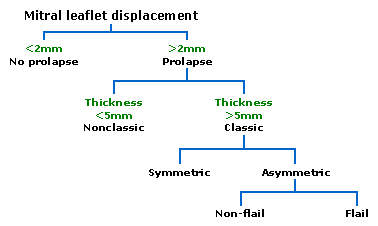Definition
Mitral valve prolapse (MVP) is a ballooning of the support structures of the mitral heart valve into the left upper collection chamber of the heart.
Description
Other names for MVP include floppy valve and Barlow's syndrome. The mitral valve is located on the left side of the heart between the top chamber (left atrium) and the bottom chamber (left ventricle). The valve opens and closes according to the heartbeat and the pressure that is exerted upon it from the blood in both chambers.
The valve has supporting structures that attach to the heart muscle to help it open and close properly. When these structures weaken or lengthen abnormally, the valve may balloon into the left atrium. Sometimes this can cause the mitral valve to leak blood backward.
This condition may be inherited and occurs in approximately 10% of the population. It affects more women than men and often peaks after the age of 40.
Causes & symptoms
MVP may occur due to rheumatic heart disease but is usually found in healthy people. Changes that occur in the valve are caused by rapid multiplication of cells in the middle layer that presses on the outer layer. The outer layer weakens, causing a prolapse of the valve toward the left atrium.
Most persons do not have symptoms. Those that do may experience sharp, left-sided chest pain. Some complain of fatigue, or a pounding feeling in the chest. Others can have an irregular heart beat and even pass out. Some persons may experience difficulty breathing, ankle swelling and fluid in the lungs. Other symptoms may include anxiety, headaches, morning tiredness and constantly cold hands and feet. Death from this condition is rare.
Diagnosis
The diagnosis of MVP is based on symptoms and physical exam. During the exam, the physician may hear a click and/or heart murmur with a stethoscope.
The best diagnostic test for MVP is the echocardiogram. The test reflects sound waves through the chest wall to give two-dimensional color flow pictures of the heart, its size, position, motion, chambers, and valves. Unfortunately, during the early 1980s, this diagnosis was often made excessively from faulty echocardiographic criteria prevalent at that time.
Any person with symptoms or family history of MVP should consider having an echocardiogram. The test takes 15-20 minutes and is done in doctor's offices and hospitals. It is performed by trained technicians and is read by cardiologists. Family physicians, internists, cardiologists, and nurse practitioners can treat MVP. Echocardiograms are recommended periodically depending on the extent of valve leakage.
Treatment
Persons who experience certain types of an irregular heartbeat with MVP should be treated. Propranolol (Inderal) or other beta blockers or digoxin (Lanoxin) are often helpful. Persons who develop moderate to severe symptoms with a leaky mitral valve may require repair or replacement of the mitral valve with an artificial heart valve. Persons with MVP and a leaky valve need to protect themselves from heart or heart valve infections. Antibiotics should be taken before any surgical, dental or oral procedures according to the American Heart Association recommendations.
Other treatments include drinking lots of fluids during strenuous activity and hot weather. Water pills, caffeine and donating blood may aggravate the symptoms of MVP.
Prognosis
MVP is usually not a serious condition. However, dangerous, untreated irregular heartbeats may rarely cause sudden death. These persons should be carefully monitored.
Key Terms
- Heart murmur
- Sound during the heartbeat caused by a heart valve that does not close properly.
- Rheumatic heart disease
- A condition caused by a streptococcus infection which can result in permanent heart damage.
Further Reading
For Your Information
Books
- LeDoux, Denise."Acquired Valvular Heart Disease." In Cardiac Nursing, edited by Susan Woods, et al. Philadelphia.: J.B. Lippincott Co., 1995.
Periodicals
- McGrath, Dicey. "Mitral Valve Prolapse." American Journal of Nursing (May 1997): 40-41.
Gale Encyclopedia of Medicine. Gale Research, 1999.



